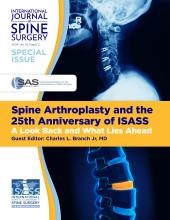ABSTRACT
Objectives This was an analytic retrospective observational study. The aims were (1) to validate patient-specific templating process by comparing postoperative range of motion (ROM) with that predicted by the model, (2) to retrospectively determine the ideal implant size, height, configuration, and location to evaluate if the ROM achieved could have been improved, and (3) to correlate postoperative ROM and clinical outcome.
Background Previous research revealed that after total disc replacement surgery, 34% of patients with less than 5° of postoperative ROM developed adjacent segment disease. The match between patient anatomy (size, facet orientation, disc height) and implant parameters are likely to affect postoperative ROM and clinical outcomes.
Methods Seventeen consecutive patients were implanted with 22 ProDisc-L devices between 2008 and 2015. Three-dimensional finite element (FE) models of the implanted segment were constructed from preoperative computed tomography scans and virtually implanted with the ProDisc-L implant. ROM was determined with the endpoints of facet impingement in flexion and implant contact in extension. FE templating was used to determine the optimal implant size and location. ROM was then measured directly from flexion and extension radiographs and compared to predicted ROM. Pre and postoperative Oswestry Disability Index (ODI) data were used to correlate ROM with clinical outcomes.
Results No significant difference was found between the actual and predicted ROM. The computational templating procedure identified an optimal ROM that was significantly greater than actual ROM. The ROM in our cohort could have been improved by an average of 1.2° or 12% had a different implant size or position been used.
Conclusions FE analyses accurately predicted ROM in this cohort and can facilitate selection of the optimal implant size and location that we believe will increase the chance of achieving clinical success with the application of this technology.
Footnotes
Disclosures and COI: Part funding for this project was provided through a research grant from the Anschutz Foundation. The authors have no relevant conflicts of interest.
- ©International Society for the Advancement of Spine Surgery







